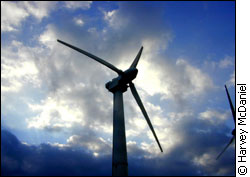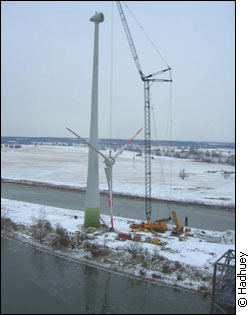
|
They are being blamed for warming the Earth's climate and polluting the air and causing wars.
The other main source of energy, nuclear power, is also not without its own controversy. Nuclear energy is by no means a clean source of energy as nuclear reactors create radioactive waste that takes centuries to break down and is difficult to store. And now, with fears that countries such as Iran and North Korea are developing there own nuclear weapons programs, the dangers of nuclear energy have been thrust into the spotlight once again. With all of the negative press that these more conventional, and often lucrative, sources of energy have been getting lately, there is one energy source that has gone relatively unnoticed. A fresh breeze In the shadow of the major conventional sources of energy, wind energy has quietly become the fastest growing source of electricity that is not produced by burning fossil fuels, says Sean Whittaker, policy director and engineer at the Canadian Wind Energy Association. "Wind energy is really just another form of solar energy," says Shawn McCallum, an Environmental Science graduate student at Carleton University who is working for the Canadian Wind Energy Association. According to McCallum, light from the sun warms the earth which in turn warms the air. When the warm air rises higher in the atmosphere, cooler air rushes in to take its place, creating wind. In particularly windy areas, wind farms, consisting of dozens or even hundreds of turbines can be built to turn some of the kinetic energy in the moving wind into electricity, explains McCallum. "When the wind hits the blades on the turbines it creates pressure differences on the blades because of their shape, much like wind rushing over and under an airplane's wing,” says McCallum. “The difference in pressure moves the blades, causing them to turn." The turning blades then turn the turbine shaft which is connected to the generator, which then generates electricity. Around the world many countries, including Canada, are rapidly developing wind energy industries. Whittaker says the main thing slowing development is the demand on turbines. "The demand on turbines is huge. There is currently a backlog at the manufacturers until 2008." This backlog has not stopped many countries from making impressive progress. Wind around the world "Currently Denmark depends on wind more than any other country in the world," says Whittaker. On average 20 per cent of the electricity used by the Danes comes from the wind but this total does change quite drastically depending on the weather and on energy demand. "Sometimes all of Denmark is running on wind," Whittaker says.
According to Whittaker, the size of Denmark's wind energy program can be attributed to the fact that the country saw the potential of wind energy early, and developed and promoted the program aggressively. The next most wind-driven countries in the world don’t even come close to Denmark's 20 per cent. Germany currently depends on wind for six per cent of its electricity and Spain for five per cent of its power. Canada has even more catching up to do. "Canada is pretty much at the back of the pack," Whittaker says. According to Whittaker, wind energy makes up less than half of a per cent of all of the electricity used by Canadians even though Canada has what Whittaker describes as an "embarrassment of riches" as far as wind resources are concerned. Despite the fact that Canada is not yet taking advantage of all its wind, many provinces have made commitments to wind energy that should boost Canada's dependency on wind from under half of a per cent to around four percent by 2013, which would move Canada into the middle of the pack, Whittaker says. Alberta currently has the most wind generators, with 275 mega watts installed. Although Canada has enough wind to satisfy all of the country's energy needs, certain factors limit the amount of electricity that can actually be produced by the wind. Factors, such as limits on the electricity grid and wind farm location restraints, have led experts to predict Canada will be able to depend on wind for 20 per cent of its power, according to the Canadian Wind Energy Association website. One turbine generates about one and a half mega watts of electricity which is enough to power between 800 to 1000 homes. Currently, the fastest growth in wind energy is occurring in China. The Chinese are aiming to install 20, 000 mega watts worth of wind generators by 2010, "which is sort of an insane figure," says Whittaker. Whittaker says 20, 000 mega watts is an enormous amount of generating capability to install in 4 years. Why wind? But why are countries all over the world, from the East to the West, trying to develop their own wind energy programs so rapidly? McCallum says there are many reasons, both environmental and economic. "There are the reasons that most people think of when they talk about wind generation," says McCallum. "Compare to other sources of electricity, wind energy is pretty clean."
Apart from the manufacturing process, wind energy doesn't contribute any greenhouse gasses to the atmosphere and it doesn’t produce any solid toxic waste, McCallum says. This is particularly appealing for countries committed to the Kyoto Accord. Still, the environmental benefits are not the only reasons many countries are pursuing wind power so vigorously. "There are significant economic benefits," Whittaker points out. "Wind farms have proven to be good boosts for rural economies, where economic downturns exist." Whittaker says despite the fact that almost all wind turbines are imported into Canada, it still takes many people to erect and maintain the enormous turbines. These people are usually drawn from the domestic workforce. Another unexpected economic benefit has been noticed. "Some of the more accessible wind farms have become tourist attractions, which is putting a little extra money into the local economies," Whittaker says. Nothing is perfect Despite the environmental and economic benefits, both Whittaker and McCallum stress that there is no energy source that is completely clean, wind included.
"Wind turbines are huge," says Whittaker. "Fossil fuels are still used during their construction and to haul them out to the wind farm sites, not to mention all the toxins released during the production of the steel used to build them." In a report published in Proceedings of the National Academy of Sciences, a group of scientists led by Professor David Keith from the University of Calgary, said that wind farms may actually promote climate change themselves. According to the report, wind turbines may actually work to alter the earths climate because they extract kinetic energy from the moving wind, which may slow the wind down. The effect of the slowed wind is a slight temperature rise in the affected area. The report says that large scale wind farming may "produce nonnegligable climatic change at continental scales." Still, the report also says that the effect that wind farming may have on the climate is no where near as drastic as the effect carbon dioxide emissions produced by burning fossil fuels is having. Whittaker agrees. "Right now, there is no completely clean source of electricity. But in comparison, wind energy is pretty good."
|
|
|

